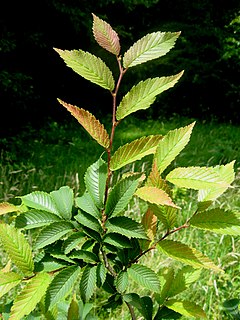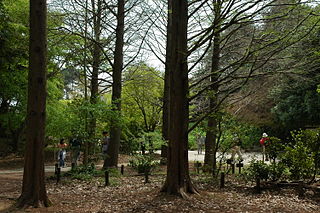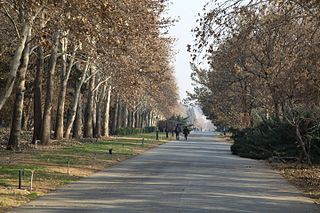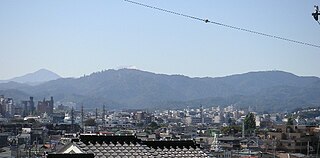
A cherry blossom is a flower of several trees of genus Prunus, particularly the Japanese cherry, Prunus serrulata, which is called sakura after the Japanese.

The Bartlett Arboretum and Gardens in Stamford, Connecticut contains 93 acres of parkland, gardens, landscapes, and hiking trails that focus on the regional plants, ecology and character of Southwestern New England. The Arboretum is open and accessible to the public every day of the year and is located at 151 Brookdale Road.

Ulmus davidiana var. japonica, the Japanese elm, is one of the larger and more graceful Asiatic elms, endemic to much of continental northeast Asia and Japan, where it grows in swamp forest on young alluvial soils, although much of this habitat has now been lost to intensive rice cultivation.

Ulmus microcarpa was named and first described by the Chinese botanist L. K. Fu, who discovered the tree in the Chayu broad-leaved forests of south-eastern Xizang at altitudes of around 2800 m during the 1973 Qinghai - Tibet Expedition. Unlike the majority of Tibet, the Chayu region has a subtropical highland climate featuring warm, wet, summers and mild, dry, winters. Commonly known as the Tibetan Elm, the tree was introduced to the United States in 2006, and the UK in 2013; it remains one of the rarest species of elm in cultivation.
Charles Edward Lane Poole was an English Australian forester who introduced systematic, science-based forestry to Western Australia.

The Koishikawa Botanical Gardens are botanical gardens with arboretum operated by the University of Tokyo Graduate School of Science. They are located at 3-7-1 Hakusan, Bunkyō, Tokyo, Japan, and open daily except Mondays; an admission fee is charged.

The Kobe Municipal Arboretum, also known as the Kobe City Forest Botanical Garden, is a 142.6-hectare botanical garden and arboretum located near Mount Maya at 4-1 Nakaichiri-yama, Shimotanigami, Yamada-cho, Kita-ku, Kobe, Japan. It is operated by the city and open daily except Wednesdays; an admission fee is charged.
The Niigata Prefectural Botanical Garden is a 19.8 hectares botanical garden and arboretum located at 186 Kanazu, Akiha-ku, Niigata, Niigata, Japan. It is open daily except Mondays; an admission fee is charged.
The Ishikawa Forest Experiment Station is an arboretum and botanical garden located at Ho-1 Banchi, Sannomiya-machi, Hakusan, Ishikawa, Japan. It is open daily; admission is free.

Northeast Forestry University, located in Harbin, Heilongjiang Province, is an institution of higher education and research under jurisdiction of the Ministry of Education of the People's Republic of China, serve as the largest forestry university in China and a key university within the scope of national "211 Project". It is a Chinese Ministry of Education Double First Class Discipline University, with Double First Class status in certain disciplines.
The Forstbotanischer Garten und Pflanzengeographisches Arboretum der Universität Göttingen, often called the Forstbotanischer Garten und Arboretum, is a 40 hectares arboretum and botanical garden maintained by the University of Göttingen. It is located at Büsgenweg 2, Göttingen, Lower Saxony, Germany, immediately adjacent to the New Botanical Garden, and open to the public daily.
The Forstbotanischer Garten in Hannoversch Münden is a forest botanical garden and arboretum located at Mitscherlichstraße 5, Hannoversch Münden, Lower Saxony, Germany.
The Arboretum Lohbrügge (10 hectares), also known as the Arboretum der Bundesforschungsanstalt für Forst- und Holzwirtschaft or the Arboretum Lohbruegge der Bundesanstalt, is an arboretum with greenhouses maintained by the German Federal Research Center for Forestry and Forest Products (BFH). It is located at Leuschnerstrasse 91, Lohbrügge, Hamburg, Germany, and open by appointment.

The Ellerhoop-Thiensen Arboretum is an arboretum and botanical garden located at Thiensen 4, Ellerhoop, Schleswig-Holstein, Germany. It is open daily; an admission fee is charged.

The Volčji Potok Arboretum was opened to the public in 1952. It originally formed part of the Souvan family estate in 1885, which was taken over by the University of Ljubljana in 1952 and legally declared a place of cultural and natural heritage of national importance. Now independent of the university, it is the most visited botanical garden in Slovenia and in recent years has become well known for its spring flower shows. The arboretum is primarily a botanical garden for woody plants, the only one in Slovenia.

National Botanical Garden of Iran is a Botanical Garden in Tehran, Iran. Its area is about 150 hectares and is planned to be the main center for horticulture and plant taxonomy in Iran. A herbarium of Iranian plants (TARI) is gradually being built up and now consists of some 160,000 numbers. Also there are gardens of non-Iranian plants such as Himalayan, American, Japanese, African, and Australian.
University of the Philippines Arboretum, also known as UP Arboretum, is a botanical garden located on the campus of the University of the Philippines Diliman in Quezon City, Philippines. It lies at the northern part of the village of U.P. Campus between the U.P.-Ayala Land TechnoHub on Commonwealth Avenue to the south and Central Avenue and the village of Culiat to the north, close to the Philippine Nuclear Research Institute. The 16-hectare (40-acre) man-made forest garden houses a collection of more than 9,000 tropical plants of about 77 unique species. It is one of few rainforests of its size located entirely within Metro Manila.

The Botanic Garden of Casimir the Great University is located in the center of Bydgoszcz, close to the main campus of the Kazimierz Wielki University in Bydgoszcz. The facility fulfils several roles: scientific research, but also didactic and recreational activities.



















